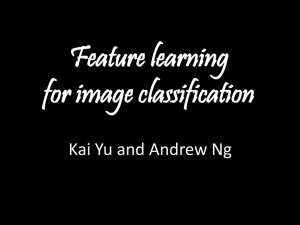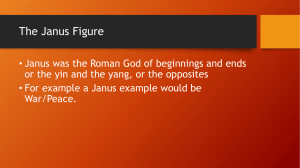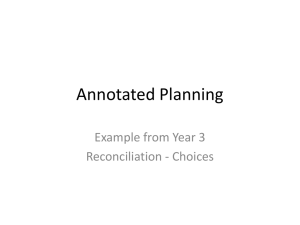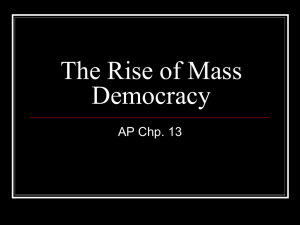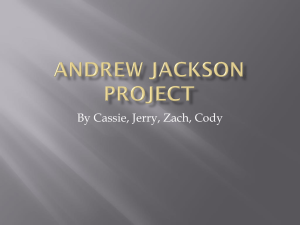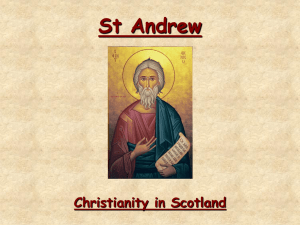Unsupervised Learning - Stanford Computer Science
advertisement
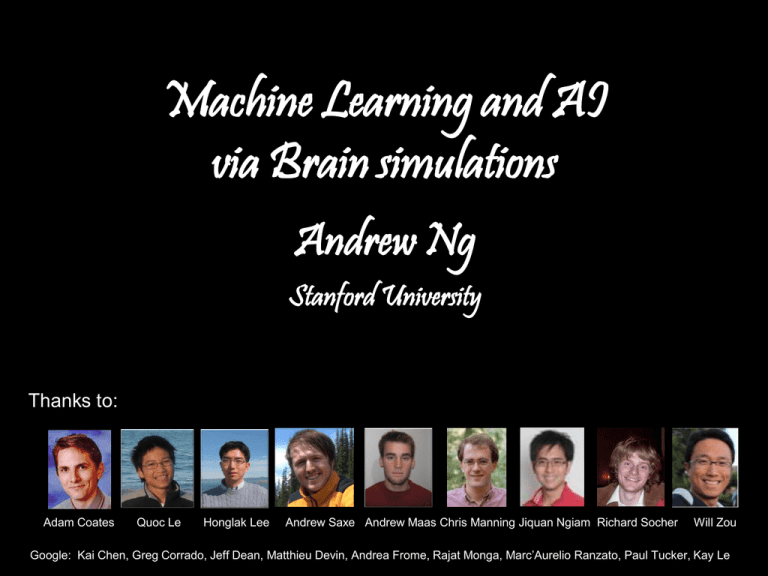
Machine Learning and AI via Brain simulations Andrew Ng Stanford University Thanks to: Adam Coates Quoc Le Honglak Lee Andrew Saxe Andrew Maas Chris Manning Jiquan Ngiam Richard Socher Will Zou Google: Kai Chen, Greg Corrado, Jeff Dean, Matthieu Devin, Andrea Frome, Rajat Monga, Marc’Aurelio Ranzato, Paul Tucker, Kay Le Andrew Ng This talk: Deep Learning Using brain simulations: - Make learning algorithms much better and easier to use. - Make revolutionary advances in machine learning and AI. Vision shared with many researchers: E.g., Samy Bengio, Yoshua Bengio, Tom Dean, Jeff Dean, Nando de Freitas, Jeff Hawkins, Geoff Hinton, Quoc Le, Yann LeCun, Honglak Lee, Tommy Poggio, Marc’Aurelio Ranzato, Ruslan Salakhutdinov, Josh Tenenbaum, Kai Yu, Jason Weston, …. I believe this is our best shot at progress towards real AI. Andrew Ng What do we want computers to do with our data? Images/video Audio Text Label: “Motorcycle” Suggest tags Image search … Speech recognition Music classification Speaker identification … Web search Anti-spam Machine translation … Andrew Ng Computer vision is hard! Motorcycle Motorcycle Motorcycle Motorcycle Motorcycle Motorcycle Motorcycle Motorcycle Motorcycle Andrew Ng What do we want computers to do with our data? Images/video Audio Text Label: “Motorcycle” Suggest tags Image search … Speech recognition Speaker identification Music classification … Web search Anti-spam Machine translation … Machine learning performs well on many of these problems, but is a lot of work. What is it about machine learning that makes it so hard to use? Andrew Ng Machine learning for image classification “Motorcycle” This talk: Develop ideas using images and audio. Ideas apply to other problems (e.g., text) too. Andrew Ng Why is this hard? You see this: But the camera sees this: Andrew Ng Machine learning and feature representations pixel 1 Learning algorithm Input pixel 2 pixel 2 Raw image Motorbikes “Non”-Motorbikes pixel 1 Andrew Ng Machine learning and feature representations pixel 1 Learning algorithm Input pixel 2 pixel 2 Raw image Motorbikes “Non”-Motorbikes pixel 1 Andrew Ng Machine learning and feature representations pixel 1 Learning algorithm Input pixel 2 pixel 2 Raw image Motorbikes “Non”-Motorbikes pixel 1 Andrew Ng What we want handlebars wheel Feature representation Learning algorithm E.g., Does it have Handlebars? Wheels? Input Features Wheels pixel 2 Raw image Motorbikes “Non”-Motorbikes pixel 1 Handlebars Andrew Ng How is computer perception done? Images/video Image Vision features Detection Audio Audio Audio features Text Text Text features Speaker ID Text classification, Machine translation, Information retrieval, .... Andrew Ng Feature representations Feature Representation Learning algorithm Input Andrew Ng Computer vision features SIFT HoG Textons Spin image RIFT GLOH Andrew Ng Audio features MFCC Spectrogram Flux ZCR Rolloff Andrew Ng NLP features Parser features Named entity recognition Stemming Coming up with features is difficult, timeconsuming, requires expert knowledge. “Applied machine learning” is basically feature engineering. Anaphora Part of speech Ontologies (WordNet) Andrew Ng Feature representations Input Feature Representation Learning algorithm Andrew Ng The “one learning algorithm” hypothesis Auditory Cortex Auditory cortex learns to see [Roe et al., 1992] Andrew Ng The “one learning algorithm” hypothesis Somatosensory Cortex Somatosensory cortex learns to see [Metin & Frost, 1989] Andrew Ng Sensor representations in the brain Seeing with your tongue Haptic belt: Direction sense Human echolocation (sonar) Implanting a 3rd eye [BrainPort; Welsh & Blasch, 1997; Nagel et al., 2005; Constantine-Paton & Law, 2009] Andrew Ng Feature learning problem • Given a 14x14 image patch x, can represent it using 196 real numbers. 255 98 93 87 89 91 48 … • Problem: Can we find a learn a better feature vector to represent this? Andrew Ng First stage of visual processing: V1 V1 is the first stage of visual processing in the brain. Neurons in V1 typically modeled as edge detectors: Neuron #1 of visual cortex (model) Neuron #2 of visual cortex (model) Andrew Ng Learning sensor representations Sparse coding (Olshausen & Field,1996) Input: Images x(1), x(2), …, x(m) (each in Rn x n) Learn: Dictionary of bases f1, f2, …, fk (also Rn x n), so that each input x can be approximately decomposed as: x k aj fj j=1 s.t. aj’s are mostly zero (“sparse”) Andrew Ng Sparse coding illustration Learned bases (f1 , …, f64): “Edges” Natural Images 50 100 150 200 50 250 100 300 150 350 200 400 250 50 300 100 450 500 50 100 150 200 350 250 300 350 400 450 150 500 200 400 250 450 300 500 50 100 150 350 200 250 300 350 100 150 400 450 500 400 450 500 50 200 250 300 350 400 450 500 Test example 0.8 * x 0.8 * + 0.3 * f36 + 0.3 * + 0.5 * f42 + 0.5 * f63 [a1, …, a64] = [0, 0, …, 0, 0.8, 0, …, 0, 0.3, 0, …, 0, 0.5, 0] More succinct, higher-level, (feature representation) representation.Andrew Ng More examples 0.6 * + 0.8 * f15 + 0.4 * f28 f37 Represent as: [a15=0.6, a28=0.8, a37 = 0.4]. 1.3 * + 0.9 * + 0.3 * f5 f18 Represent as: [a5=1.3, a18=0.9, a29 = 0.3]. f29 • Method “invents” edge detection. • Automatically learns to represent an image in terms of the edges that appear in it. Gives a more succinct, higher-level representation than the raw pixels. • Quantitatively similar to primary visual cortex (area V1) in brain. Andrew Ng Sparse coding applied to audio Image shows 20 basis functions learned from unlabeled audio. [Evan Smith & Mike Lewicki, 2006] Andrew Ng Sparse coding applied to audio Image shows 20 basis functions learned from unlabeled audio. [Evan Smith & Mike Lewicki, 2006] Andrew Ng Learning feature hierarchies Higher layer (Combinations of edges; cf. V2) a1 x1 a2 x2 “Sparse coding” (edges; cf. V1) a3 x3 x4 Input image (pixels) [Technical details: Sparse autoencoder or sparse version of Hinton’s DBN.] [Lee, Ranganath & Ng,Andrew 2007] Ng Learning feature hierarchies Higher layer (Model V3?) Higher layer (Model V2?) a1 x1 a2 x2 a3 x3 Model V1 x4 Input image [Technical details: Sparse autoencoder or sparse version of Hinton’s DBN.] [Lee, Ranganath & Ng,Andrew 2007] Ng Hierarchical Sparse coding (Sparse DBN): Trained on face images object models object parts (combination of edges) Training set: Aligned images of faces. edges pixels [Honglak Lee] Andrew Ng Machine learning applications Andrew Ng Unsupervised feature learning (Self-taught learning) Motorcycles Not motorcycles Testing: What is this? … Unlabeled images [Lee, Raina and Ng, 2006; Raina, Lee, Battle, Packer & Ng, 2007] Andrew Ng Video Activity recognition (Hollywood 2 benchmark) Method Accuracy Hessian + ESURF [Williems et al 2008] 38% Harris3D + HOG/HOF [Laptev et al 2003, 2004] 45% Cuboids + HOG/HOF [Dollar et al 2005, Laptev 2004] 46% Hessian + HOG/HOF [Laptev 2004, Williems et al 2008] 46% Dense + HOG / HOF [Laptev 2004] 47% Cuboids + HOG3D [Klaser 2008, Dollar et al 2005] 46% Unsupervised feature learning (our method) 52% Unsupervised feature learning significantly improves on the previous state-of-the-art. [Le, Zhou & Ng, 2011] Andrew Ng Audio TIMIT Phone classification Accuracy TIMIT Speaker identification Accuracy Prior art (Clarkson et al.,1999) 79.6% Prior art (Reynolds, 1995) 99.7% Stanford Feature learning 80.3% Stanford Feature learning 100.0% Images CIFAR Object classification Accuracy NORB Object classification Accuracy Prior art (Ciresan et al., 2011) 80.5% Prior art (Scherer et al., 2010) 94.4% Stanford Feature learning 82.0% Stanford Feature learning 95.0% Galaxy Video Hollywood2 Classification Accuracy YouTube Accuracy Prior art (Laptev et al., 2004) 48% Prior art (Liu et al., 2009) 71.2% Stanford Feature learning 53% Stanford Feature learning 75.8% KTH Accuracy UCF Accuracy Prior art (Wang et al., 2010) 92.1% Prior art (Wang et al., 2010) 85.6% Stanford Feature learning 93.9% Stanford Feature learning 86.5% Text/NLP Multimodal (audio/video) AVLetters Lip reading Paraphrase detection Accuracy Sentiment (MR/MPQA data) Accuracy (Zhao&et al., 2009) Prior art (Das Smith, 2009) 58.9% 76.1% Prior art (Nakagawa et al., 2010) 77.3% Stanford Feature learning 65.8% 76.4% Stanford Feature learning 77.7% Andrew Ng How do you build a high accuracy learning system? Andrew Ng • Choices of learning algorithm: – Memory based – Winnow – Perceptron – Naïve Bayes – SVM – …. Accuracy Supervised Learning: Labeled data • What matters the most? Training set size (millions) [Banko & Brill, 2001] “It’s not who has the best algorithm that wins. It’s who has the most data.” Andrew Ng Unsupervised Learning Large numbers of features is critical. The specific learning algorithm is important, but ones that can scale to many features also have a big advantage. [Adam Coates] Andrew Ng Learning from Labeled data Model Training Data Model Machine (Model Partition) Training Data Model Training Data Machine (Model Partition) Core Basic DistBelief Model Training Model Training Data • • Unsupervised or Supervised Objective • • Model parameters sharded by partition Minibatch Stochastic Gradient Descent (SGD) 10s, 100s, or 1000s of cores per model Basic DistBelief Model Training Model Parallelize across ~100 machines (~1600 cores). But training is still slow with large data sets. Training Data Add another dimension of parallelism, and have multiple model instances in parallel. Asynchronous Distributed Stochastic Gradient Descent = p=+p∆p ’ + ∆p’ Parameter Server p’p’’ ∆p’ ∆p Model Data p p’ Asynchronous Distributed Stochastic Gradient Descent Parameter Server p’ = p + ∆p ∆p Model Workers Data Shards p’ Asynchronous Distributed Stochastic Gradient Descent Parameter Server Slave models Data Shards From an engineering standpoint, superior to a single model with the same number of total machines: • • Better robustness to individual slow machines Makes forward progress even during evictions/restarts Acoustic Modeling for Speech Recognition Async SGD and L-BFGS can both speed up model training. To reach the same model quality DistBelief reached in 4 days took 55 days using a GPU.... DistBelief can support much larger models than a GPU (useful for unsupervised learning). Andrew Ng Speech recognition on Android Andrew Ng Application to Google Streetview [with Yuval Netzer, Julian Ibarz] Andrew Ng Learning from Unlabeled data Andrew Ng • Choices of learning algorithm: – Memory based – Winnow – Perceptron – Naïve Bayes – SVM – …. Accuracy Supervised Learning • What matters the most? Training set size (millions) [Banko & Brill, 2001] “It’s not who has the best algorithm that wins. It’s who has the most data.” Andrew Ng Unsupervised Learning Large numbers of features is critical. The specific learning algorithm is important, but ones that can scale to many features also have a big advantage. [Adam Coates] Andrew Ng 50 thousand 32x32 images 10 million parameters 10 million 200x200 images 1 billion parameters Training procedure What features can we learn if we train a massive model on a massive amount of data. Can we learn a “grandmother cell”? • Train on 10 million images (YouTube) • 1000 machines (16,000 cores) for 1 week. • Test on novel images Training set (YouTube) Test set (FITW + ImageNet) The face neuron Top stimuli from the test set Optimal stimulus by numerical optimization Le, et al., Building high-level features using large-scale unsupervised learning. ICML 2012 Cat neuron Top Stimuli from the test set Average of top stimuli from test set ImageNet classification: 22,000 classes … smoothhound, smoothhound shark, Mustelus mustelus American smooth dogfish, Mustelus canis Florida smoothhound, Mustelus norrisi whitetip shark, reef whitetip shark, Triaenodon obseus Atlantic spiny dogfish, Squalus acanthias Pacific spiny dogfish, Squalus suckleyi hammerhead, hammerhead shark smooth hammerhead, Sphyrna zygaena smalleye hammerhead, Sphyrna tudes shovelhead, bonnethead, bonnet shark, Sphyrna tiburo angel shark, angelfish, Squatina squatina, monkfish electric ray, crampfish, numbfish, torpedo smalltooth sawfish, Pristis pectinatus guitarfish roughtail stingray, Dasyatis centroura butterfly ray eagle ray spotted eagle ray, spotted ray, Aetobatus narinari cownose ray, cow-nosed ray, Rhinoptera bonasus manta, manta ray, devilfish Atlantic manta, Manta birostris devil ray, Mobula hypostoma grey skate, gray skate, Raja batis little skate, Raja erinacea … Stingray Mantaray 0.005% 9.5% ? Random guess State-of-the-art (Weston, Bengio ‘11) Feature learning From raw pixels Le, et al., Building high-level features using large-scale unsupervised learning. ICML 2012 0.005% 9.5% Random guess State-of-the-art (Weston, Bengio ‘11) 21.3% Feature learning From raw pixels Le, et al., Building high-level features using large-scale unsupervised learning. ICML 2012 Discussion: Engineering vs. Data Andrew Ng Discussion: Engineering vs. Data Contribution to performance Human ingenuity Data/ learning Andrew Ng Discussion: Engineering vs. Data Contribution to performance Time Now Andrew Ng Deep Learning • Deep Learning: Lets learn our features. • Discover the fundamental computational principles that underlie perception. • Scaling up has been key to achieving good performance. • Didn’t talk about: Recursive deep learning for NLP. • Online machine learning class: http://ml-class.org • Online tutorial on deep learning: http://deeplearning.stanford.edu/wiki Stanford Adam Coates Quoc Le Honglak Lee Andrew Saxe Andrew Maas Chris Manning Jiquan Ngiam Richard Socher Will Zou Google Kai Chen Greg Corrado Jeff Dean Matthieu Devin Andrea Frome Rajat Monga Marc’Aurelio Ranzato Paul Tucker Kay Le Andrew Ng END END END Andrew Ng Training procedure What features can we learn if we train a massive model on a massive amount of data. Can we learn a “grandmother cell”? • Train on 10 million images (YouTube) • 1000 machines (16,000 cores) for 1 week. • 1.15 billion parameters • Test on novel images Training set (YouTube) Test set (FITW + ImageNet) Andrew Ng Face neuron Top Stimuli from the test set Optimal stimulus by numerical optimization Andrew Ng Cat neuron Top Stimuli from the test set Average of top stimuli from test set Andrew Ng ImageNet classification 20,000 categories 16,000,000 images Others: Hand-engineered features (SIFT, HOG, LBP), Spatial pyramid, SparseCoding/Compression Le, et al., Building high-level features using large-scale unsupervised learning. ICML 2012 Best stimuli Feature 1 Feature 2 Feature 3 Feature 4 Feature 5 Le, et al., Building high-level features using large-scale unsupervised learning. ICML 2012 Best stimuli Feature 6 Feature 7 Feature 8 Feature 9 Le, et al., Building high-level features using large-scale unsupervised learning. ICML 2012 Best stimuli Feature 10 Feature 11 Feature 12 Feature 13 Le, et al., Building high-level features using large-scale unsupervised learning. ICML 2012 20,000 is a lot of categories… … smoothhound, smoothhound shark, Mustelus mustelus American smooth dogfish, Mustelus canis Florida smoothhound, Mustelus norrisi whitetip shark, reef whitetip shark, Triaenodon obseus Atlantic spiny dogfish, Squalus acanthias Pacific spiny dogfish, Squalus suckleyi hammerhead, hammerhead shark smooth hammerhead, Sphyrna zygaena smalleye hammerhead, Sphyrna tudes shovelhead, bonnethead, bonnet shark, Sphyrna tiburo angel shark, angelfish, Squatina squatina, monkfish electric ray, crampfish, numbfish, torpedo smalltooth sawfish, Pristis pectinatus guitarfish roughtail stingray, Dasyatis centroura butterfly ray eagle ray spotted eagle ray, spotted ray, Aetobatus narinari cownose ray, cow-nosed ray, Rhinoptera bonasus manta, manta ray, devilfish Atlantic manta, Manta birostris devil ray, Mobula hypostoma grey skate, gray skate, Raja batis little skate, Raja erinacea … Stingray Mantaray 0.005% 9.5% ? Random guess State-of-the-art (Weston, Bengio ‘11) Feature learning From raw pixels Le, et al., Building high-level features using large-scale unsupervised learning. ICML 2012 0.005% 9.5% Random guess State-of-the-art (Weston, Bengio ‘11) 15.8% Feature learning From raw pixels ImageNet 2009 (10k categories): Best published result: 17% (Sanchez & Perronnin ‘11 ), Our method: 20% Using only 1000 categories, our method > 50% Le, et al., Building high-level features using large-scale unsupervised learning. ICML 2012 Speech recognition on Android Andrew Ng Application to Google Streetview [with Yuval Netzer, Julian Ibarz] Andrew Ng Scaling up with HPC “Cloud” infrastructure GPUs with CUDA Many inexpensive nodes. Comm. bottlenecks, node failures. 1 very fast node. Limited memory; hard to scale out. Infiniband fabric HPC cluster: GPUs with Infiniband Difficult to program---lots of MPI and CUDA code. Andrew Ng Stanford GPU cluster • Current system – 64 GPUs in 16 machines. – Tightly optimized CUDA for UFL/DL operations. – 47x faster than single-GPU implementation. 64 11.2B 6.9B Factor Speedup 32 3.0B 1.9B 16 680M 185M 8 Linear 4 2 1 1 4 9 16 36 64 # GPUs – Train 11.2 billion parameter, 9 layer neural network in < 4 days. Andrew Ng Conclusion Andrew Ng Unsupervised Feature Learning Summary • Deep Learning and Self-Taught learning: Lets learn rather than manually design our features. • Discover the fundamental computational principles that underlie perception? Motorcycle Car Unlabeled images • Sparse coding and deep versions very successful on vision and audio tasks. Other variants for learning recursive representations. • To get this to work for yourself, see online tutorial: http://deeplearning.stanford.edu/wiki or go/brain Stanford Adam Coates Quoc Le Honglak Lee Andrew Saxe Andrew Maas Chris Manning Jiquan Ngiam Richard Socher Will Zou Google Kai Chen Greg Corrado Jeff Dean Matthieu Devin Andrea Frome Rajat Monga Marc’Aurelio Ranzato Paul Tucker Kay Le Andrew Ng Advanced Topics Andrew Ng Stanford University & Google Andrew Ng Language: Learning Recursive Representations Andrew Ng Feature representations of words Imagine taking each word, and computing an n-dimensional feature vector for it. [Distributional representations, or Bengio et al., 2003, Collobert & Weston, 2008.] 2-d embedding example below, but in practice use ~100-d embeddings. 5 x2 Monday 4 2 4 8 5 2.1 3.3 Tuesday 3 On 2 Britain 9 2 1 France 9.5 1.5 0 1 2 3 On Representation: 8 5 4 5 6 x1 7 8 9 0 0 0 0 1 0 0 0 Monday 0 1 0 0 0 0 0 0 Britain 10 Monday, Britain …. 2 4 9 2 Andrew Ng “Generic” hierarchy on text doesn’t make sense Node has to represent sentence fragment “cat sat on.” Doesn’t make sense. 9 1 The 5 3 The cat 7 1 8 5 9 1 cat sat on the 4 3 mat. Feature representation for words Andrew Ng What we want (illustration) This node’s job is to represent “on the mat.” S VP PP NP NP 9 1 The 5 3 The cat 7 1 8 5 9 1 cat sat on the 4 3 mat. Andrew Ng What we want (illustration) 5 4 This node’s job is to represent “on the mat.” S 7 3 VP 8 3 5 2 9 1 The PP NP 5 3 The cat 3 3 7 1 8 5 9 1 cat sat on the NP 4 3 mat. Andrew Ng What we want (illustration) 5 x2 The day after my birthday Monday Tuesday 4 3 The country of my birth Britain 2 France 1 0 1 2 3 4 5 6 x1 7 8 9 10 3 5 9 3 8 3 9 2 3 3 5 2 8 g 5 The 2 4 9 2 3 2 day after my 3 2 2 8 9 2 birthday, … 8 g 5 9 2 The country 9 9 of 3 2 my 2 2 birth… Andrew Ng Learning recursive representations This node’s job is to represent “on the mat.” 8 3 3 3 The cat 8 5 9 1 on the 4 3 mat. Andrew Ng Learning recursive representations This node’s job is to represent “on the mat.” 8 3 3 3 The cat 8 5 9 1 on the 4 3 mat. Andrew Ng Learning recursive representations Basic computational unit: Neural Network that inputs two candidate children’s representations, and outputs: • Whether we should merge the two nodes. • The semantic representation if the two nodes are merged. “Yes” This node’s job is to represent “on the mat.” 8 3 8 3 3 3 Neural Network The 8 5 cat 8 5 9 1 on the 4 3 mat. 3 3 Andrew Ng Parsing a sentence 5 2 Yes Neural Network 9 1 The No 0 1 No Neural Network 5 3 The cat 0 1 No 0 0 Neural Network Neural Network 7 1 8 5 9 1 cat sat on the 3 3 Yes Neural Network 4 3 mat. Andrew Ng Parsing a sentence 0 1 No No 0 1 Yes Neural Network Neural Network Neural Network 5 2 9 1 The 8 3 3 3 5 3 The cat 7 1 8 5 9 1 cat sat on the 4 3 mat. Andrew Ng Parsing a sentence No 0 1 Yes Neural Network 8 3 Neural Network 5 2 3 3 9 1 5 3 8 5 9 1 The cat on the 4 3 mat. [Socher, ManningAndrew & Ng] Ng Parsing a sentence 5 4 7 3 8 3 5 2 9 1 The 3 3 5 3 The cat 7 1 8 5 9 1 cat sat on the 4 3 mat. Andrew Ng Finding Similar Sentences • • • Each sentence has a feature vector representation. Pick a sentence (“center sentence”) and list nearest neighbor sentences. Often either semantically or syntactically similar. (Digits all mapped to 2.) Similarities Center Sentence Nearest Neighbor Sentences (most similar feature vector) Bad News Both took further hits yesterday 1. We 're in for a lot of turbulence ... 2. BSN currently has 2.2 million common shares outstanding 3. This is panic buying 4. We have a couple or three tough weeks coming Something said I had calls all night long from the States, he said 1. Our intent is to promote the best alternative, he says 2. We have sufficient cash flow to handle that, he said 3. Currently, average pay for machinists is 22.22 an hour, Boeing said 4. Profit from trading for its own account dropped, the securities firm said Gains and good news Fujisawa gained 22 to 2,222 1. 2. 3. 4. Mochida advanced 22 to 2,222 Commerzbank gained 2 to 222.2 Paris loved her at first sight Profits improved across Hess's businesses Unknown words which are cities Columbia , S.C 1. 2. 3. 4. Greenville , Miss UNK , Md UNK , Miss UNK , Calif Andrew Ng Finding Similar Sentences Similarities Center Sentence Nearest Neighbor Sentences (most similar feature vector) Declining to comment = not disclosing Hess declined to comment 1. 2. 3. 4. PaineWebber declined to comment Phoenix declined to comment Campeau declined to comment Coastal wouldn't disclose the terms Large changes in sales or revenue Sales grew almost 2 % to 222.2 million from 222.2 million 1. 2. 3. 4. Sales surged 22 % to 222.22 billion yen from 222.22 billion Revenue fell 2 % to 2.22 billion from 2.22 billion Sales rose more than 2 % to 22.2 million from 22.2 million Volume was 222.2 million shares , more than triple recent levels Negation of different types There's nothing unusual about business groups pushing for more government spending 1. We don't think at this point anything needs to be said 2. It therefore makes no sense for each market to adopt different circuit breakers 3. You can't say the same with black and white 4. I don't think anyone left the place UNK UNK People in bad situations We were lucky 1. 2. 3. 4. It was chaotic We were wrong People had died They still are Andrew Ng Application: Paraphrase Detection • Task: Decide whether or not two sentences are paraphrases of each other. (MSR Paraphrase Corpus) Method F1 Baseline 79.9 Rus et al., (2008) 80.5 Mihalcea et al., (2006) 81.3 Islam et al. (2007) 81.3 Qiu et al. (2006) 81.6 Fernando & Stevenson (2008) (WordNet based features) 82.4 Das et al. (2009) 82.7 Wan et al (2006) (many features: POS, parsing, BLEU, etc.) 83.0 Stanford Feature Learning 83.4 Andrew Ng Parsing sentences and parsing images A small crowd quietly enters the historic church. Each node in the hierarchy has a “feature vector” representation. Andrew Ng Nearest neighbor examples for image patches • • • Each node (e.g., set of merged superpixels) in the hierarchy has a feature vector. Select a node (“center patch”) and list nearest neighbor nodes. I.e., what image patches/superpixels get mapped to similar features? Selected patch Nearest Neighbors Andrew Ng Multi-class segmentation (Stanford background dataset) Method Accuracy Pixel CRF (Gould et al., ICCV 2009) 74.3 Classifier on superpixel features 75.9 Region-based energy (Gould et al., ICCV 2009) 76.4 Local labelling (Tighe & Lazebnik, ECCV 2010) 76.9 Superpixel MRF (Tighe & Lazebnik, ECCV 2010) 77.5 Simultaneous MRF (Tighe & Lazebnik, ECCV 2010) 77.5 Stanford Feature learning (our method) 78.1 Andrew Ng Multi-class Segmentation MSRC dataset: 21 Classes Methods Accuracy TextonBoost (Shotton et al., ECCV 2006) 72.2 Framework over mean-shift patches (Yang et al., CVPR 2007) 75.1 Pixel CRF (Gould et al., ICCV 2009) 75.3 Region-based energy (Gould et al., IJCV 2008) 76.5 Stanford Feature learning (out method) 76.7 Andrew Ng Analysis of feature learning algorithms Andrew Coates Honglak Lee Andrew Ng Supervised Learning Training set size Accuracy • Choices of learning algorithm: – Memory based – Winnow – Perceptron – Naïve Bayes – SVM – …. • What matters the most? [Banko & Brill, 2001] “It’s not who has the best algorithm that wins. It’s who has the most data.” Andrew Ng Unsupervised Feature Learning • Many choices in feature learning algorithms; – Sparse coding, RBM, autoencoder, etc. – Pre-processing steps (whitening) – Number of features learned – Various hyperparameters. • What matters the most? Andrew Ng Unsupervised feature learning Most algorithms learn Gabor-like edge detectors. Sparse auto-encoder Andrew Ng Unsupervised feature learning Weights learned with and without whitening. with whitening without whitening with whitening Sparse auto-encoder with whitening without whitening K-means without whitening Sparse RBM with whitening without whitening Gaussian mixture model Andrew Ng Scaling and classification accuracy (CIFAR-10) Andrew Ng

